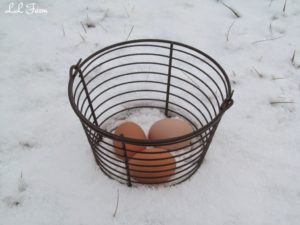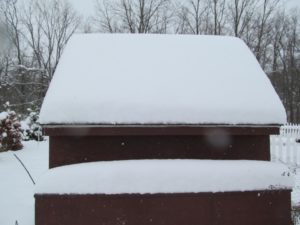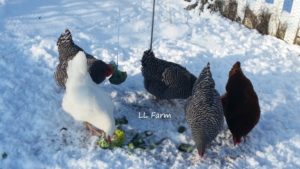 The first snowfall of the season happened the other day. Although beautiful to me, it was a bit of a shock to the new girls in the chicken coop. When I opened the door to let the chickens out in the morning, none of them eagerly came out as they normally would. In this picture, it looks like they are saying something like “I don’t know what that white stuff is…you go out first!”
The first snowfall of the season happened the other day. Although beautiful to me, it was a bit of a shock to the new girls in the chicken coop. When I opened the door to let the chickens out in the morning, none of them eagerly came out as they normally would. In this picture, it looks like they are saying something like “I don’t know what that white stuff is…you go out first!”
Thankfully, I was ready for the snow…
PREPARATION
It’s like anything worth doing right…the preparation is key! Every year we try to prepare ahead of time! This year, before the snow and cold hit, we made the necessary repairs to our coop, which is a few years old now. If your coop has damage, holes or cracks, now is a good time to fix them, before the cold air creeps in, which may cause frostbite or illness to your flock.

COZY COOP
Although I use the deep litter method all year long, I do tend to add more straw this time of year, making for a cozy coop for my ladies. Making sure there is plenty of straw in the nesting boxes also helps to prevent eggs from freezing before I am able to collect them.

Speaking of a cozy coop…did you know that snow on the coop roof can act as insulation? (Think about igloos!)

FOOD AND WATER
Chickens don’t overeat, so I try to make sure that they always have access to food. Layer crumbles or pellets should be the main source of food for hens year-round, with treats and kitchen scraps added in as a bonus. Hanging vegetables or tucking them into a suet cage feeder offers exercise and added nutrients, which can help aid natural survival skills in the chickens.
Having water available at all times is crucial to a chicken’s health, which may mean extra work for us on those bitter days. Busting ice or changing the water more frequently may be necessary. For the cold, winter months, I change from using the galvanized water containers to using the plastic ones. The plastic containers absorb the sunlight and don’t seem to freeze as fast.

A BATHING AREA
As the cold weather settles into my bones, I love to cozy up to a warm fire. When the ash bucket gets full, I dump it into the fenced chicken yard for the ladies to take baths in. Remember, to use only wood ash, nothing chemically treated.
So there you have it…just a few winter tips for raising chickens.












